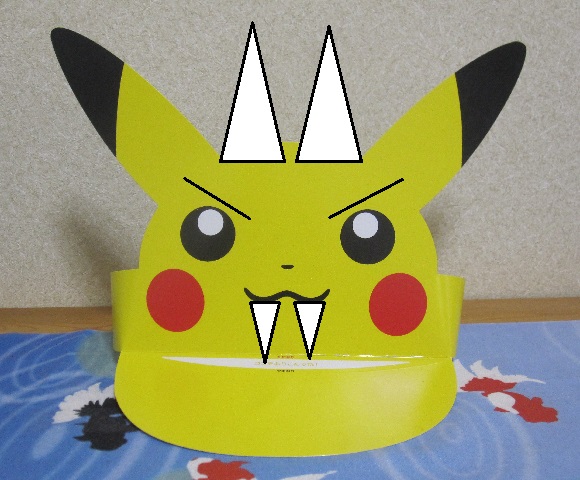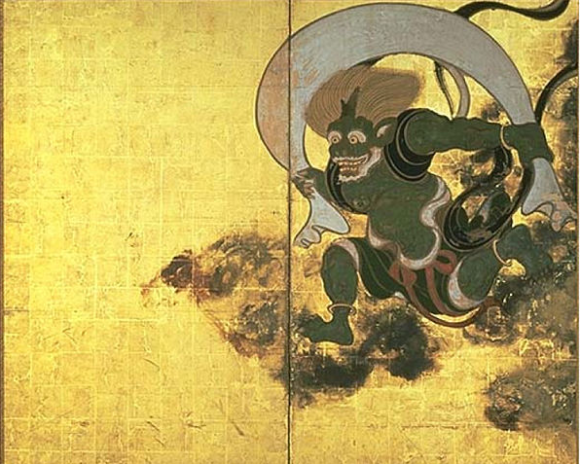
Also, Pokémon character designer reveals that his name is NOT supposed to mean “electric mouse.”
Close your eyes and imagine Pikachu (oh, and also remember to open your eyes back up again so you can continue reading this article). You can see him clearly in your mind’s eye, right? That cuddly build, friendly smile, and rosy cheeks are just the ultimate in disarmingly cute character design, aren’t they?
Okay, now close your eyes again, and this time imagine Pikachu with fangs and horns.
Crazy as it might seem, 22 years after the release of Pokémon Red and Green, the initial installments of the video game series, those fearsome features really were part of the initial concept for Pikachu’s evolution path. Earlier this month, we learned that Pikachu, which evolves into Raichu, was originally planned to have a third evolutionary tier, and in a recent interview Pokémon Red and Green character designers Ken Sugumori and Atsuko Nishida shed more light on the lost Pokémon.
Following Raichu, Pikachu’s next evolution was going to be called Gorochu. “Goro” is a relatively common, if somewhat old-fashioned, Japanese men’s name with a bulky, masculine ring to it, and Gorochu was going to be suitably macho in design. The Pocket Monster would have had sharp fangs and horns protruding from his forehead. “He was going to look something like Kaminari-sama,” recalls Nishida, referring to a thunder deity (more formally called Raijin) often depicted in Japanese religious or mythological art.
▼ Pika…?
So why was Gorochu cut from the final version of the game? One reason was for gameplay balance, but another major factor was memory space. Pokémon Red and Green was made for Nintendo’s Game Boy, which was much more a workhorse than a powerhouse in terms of hardware specs. There wasn’t enough memory available in the cartridge for every Pokémon to have two evolutions, and since Pikachu wasn’t originally one of the selectable starter Pokémon, Gorochu was axed.
The technical limitations of the Game Boy also affected the Pikachu design itself. Ever wondered why the tips of Pikachu’s ears are black, as opposed to yellow like most of his body? Because the standard Game Boy had a black-and-white screen, and adding color to the tips of his ears made them more expressive by allowing artists to show which way they were pointing or leaning. Another bit of trivia: there’s no special significance to Pikachu’s Pokédex number being 25, as the game’s staff simply numbered the Pokémon in the approximate order they expected players to encounter them in when playing through the game.
While reminiscing about Pikachu’s origins, Nishida, who chose the character’s name, also dispelled the often-repeated explanation that Pikachu comes from pika (the Japanese onomatopoeia for a flash of light) and chu (the onomatopoeia for a mouse’s squeak). It turns out that popular theory is only half right; the “pika”/flash part is correct, but Nishida says she chose the “chu” simply based on its sound and length, reiterating that she never consciously intended to make Pikachu look like a mouse. “By the time I was designing Pikachu, we already had a mouse-like Pokémon with Rattata,” she says.
▼ Rattata
https://twitter.com/CallyMac666/status/997938798230212609But while Pikachu was never meant to be a cute mouse, he was undeniably cute. One of his earliest fans was Koji Nishino, a planner for Pokémon Red and Green. Nishino liked Pikachu so much that he actually got a little covetously protective, purposely lowering the encounter rate for the now-famous Electric-Type. In doing so, however, he inadvertently made Pikachu one of the first “rare” Pokémon players are able to find, making him all the more popular and helping to propel him to his status as the long-running series’ biggest star.
Source: The Pokémon Company via Hachima Kiko
Top image ©SoraNews24
Insert image: Wikipedia/Kca
Follow Casey on Twitter, where he’s finding having a sizable stash of Pikachu visors in his home to be quite handy.


 Shocking news! Star Pokémon Pikachu’s design isn’t based on a mouse
Shocking news! Star Pokémon Pikachu’s design isn’t based on a mouse Pokémon of the Year results announced, and Pikachu wasn’t even close to winning【Video】
Pokémon of the Year results announced, and Pikachu wasn’t even close to winning【Video】 New Pokémon earrings and hair accessories will have you looking Pikachu-perfect
New Pokémon earrings and hair accessories will have you looking Pikachu-perfect We’re going to see Pikachu as a baby in the new Pokémon anime!【Video】
We’re going to see Pikachu as a baby in the new Pokémon anime!【Video】 Pikachu’s voice actress talks about the challenges of playing the most famous Pokémon of all
Pikachu’s voice actress talks about the challenges of playing the most famous Pokémon of all Disillusionment at Tsukiji’s tourist-target prices led us to a great ramen restaurant in Tokyo
Disillusionment at Tsukiji’s tourist-target prices led us to a great ramen restaurant in Tokyo Lacquerware supplier to emperor of Japan and Pokémon team up for new tableware
Lacquerware supplier to emperor of Japan and Pokémon team up for new tableware Large amount of supposed human organs left in Osaka marketplace
Large amount of supposed human organs left in Osaka marketplace Street Fighter Hadouken Churros to be launched and eaten in Tokyo, Okami pudding on offer too
Street Fighter Hadouken Churros to be launched and eaten in Tokyo, Okami pudding on offer too Solar Chef: We tried cooking an egg using the power of the sun and a magnifying glass
Solar Chef: We tried cooking an egg using the power of the sun and a magnifying glass Tokyo train stations get new Olympic melodies and signage for the Games
Tokyo train stations get new Olympic melodies and signage for the Games Japan’s permanent Pokémon theme park zone announces grand opening date, ticket sale start
Japan’s permanent Pokémon theme park zone announces grand opening date, ticket sale start Step into Japanese culture with Converse’s new Japan-exclusive shoes featuring gods, sushi style
Step into Japanese culture with Converse’s new Japan-exclusive shoes featuring gods, sushi style A Japanese dating app matched our bachelorette with a Buddhist monk, and she learned some things
A Japanese dating app matched our bachelorette with a Buddhist monk, and she learned some things Starbucks Japan releases new zodiac chilled cup drink for 2026
Starbucks Japan releases new zodiac chilled cup drink for 2026 7-Eleven Japan starts new temporary luggage storage service in over 300 branches
7-Eleven Japan starts new temporary luggage storage service in over 300 branches Starbucks teams up with 166-year-old Kyoto doll maker for Year of the Horse decorations【Photos】
Starbucks teams up with 166-year-old Kyoto doll maker for Year of the Horse decorations【Photos】 Tokyo’s Tsukiji sushi neighborhood asks tour groups to stay away for the rest of the month
Tokyo’s Tsukiji sushi neighborhood asks tour groups to stay away for the rest of the month Japanese woman mistaken for bear
Japanese woman mistaken for bear Return of Totoro sequel short anime announced for Ghibli Park
Return of Totoro sequel short anime announced for Ghibli Park Is this the most relaxing Starbucks in Japan?
Is this the most relaxing Starbucks in Japan? Starbucks on a Shinkansen bullet train platform: 6 tips for using the automated store in Japan
Starbucks on a Shinkansen bullet train platform: 6 tips for using the automated store in Japan Japan’s human washing machines will go on sale to general public, demos to be held in Tokyo
Japan’s human washing machines will go on sale to general public, demos to be held in Tokyo Japanese train company is letting fans buy its actual ticket gates for their homes
Japanese train company is letting fans buy its actual ticket gates for their homes Is China’s don’t-go-to-Japan warning affecting tourist crowds in Tokyo’s Asakusa neighborhood?
Is China’s don’t-go-to-Japan warning affecting tourist crowds in Tokyo’s Asakusa neighborhood? Starbucks Japan unveils new Christmas goods and a rhinestone tumbler that costs 19,500 yen
Starbucks Japan unveils new Christmas goods and a rhinestone tumbler that costs 19,500 yen Tokyo considering law requiring more trash cans following litter increase in heavily touristed area
Tokyo considering law requiring more trash cans following litter increase in heavily touristed area Nintendo’s Kirby now delivering orders at Kura Sushi restaurants, but not in Japan
Nintendo’s Kirby now delivering orders at Kura Sushi restaurants, but not in Japan Tokyo event lets you travel back in time, for free, to celebrate 100 years since Showa era start
Tokyo event lets you travel back in time, for free, to celebrate 100 years since Showa era start Survey asks foreign tourists what bothered them in Japan, more than half gave same answer
Survey asks foreign tourists what bothered them in Japan, more than half gave same answer Japan’s deadliest food claims more victims, but why do people keep eating it for New Year’s?
Japan’s deadliest food claims more victims, but why do people keep eating it for New Year’s? We deeply regret going into this tunnel on our walk in the mountains of Japan
We deeply regret going into this tunnel on our walk in the mountains of Japan Studio Ghibli releases Kodama forest spirits from Princess Mononoke to light up your home
Studio Ghibli releases Kodama forest spirits from Princess Mononoke to light up your home Major Japanese hotel chain says reservations via overseas booking sites may not be valid
Major Japanese hotel chain says reservations via overseas booking sites may not be valid Put sesame oil in your coffee? Japanese maker says it’s the best way to start your day【Taste test】
Put sesame oil in your coffee? Japanese maker says it’s the best way to start your day【Taste test】 The top 10 annoying foreign tourist behaviors on trains, as chosen by Japanese people【Survey】
The top 10 annoying foreign tourist behaviors on trains, as chosen by Japanese people【Survey】 No more using real katana for tourism activities, Japan’s National Police Agency says
No more using real katana for tourism activities, Japan’s National Police Agency says Starbucks Japan reveals new sakura drinkware collection, inspired by evening cherry blossoms
Starbucks Japan reveals new sakura drinkware collection, inspired by evening cherry blossoms New Pokémon dress sock line brings Pikachu and pals to your fashionable grown-up feet【Photos】
New Pokémon dress sock line brings Pikachu and pals to your fashionable grown-up feet【Photos】 Pikachu makes vocalist debut with brand-new “Pikachu’s Song” 【Video】
Pikachu makes vocalist debut with brand-new “Pikachu’s Song” 【Video】 Believe it or not, you already know every single lyric to the new Pokémon Pikachu theme song
Believe it or not, you already know every single lyric to the new Pokémon Pikachu theme song New Google Home/Amazon Alexa app lets you have conversations with Pikachu!
New Google Home/Amazon Alexa app lets you have conversations with Pikachu! Pikachu freestyle raps in battle with fellow Pokémon Mimikyu【Video】
Pikachu freestyle raps in battle with fellow Pokémon Mimikyu【Video】 The mystery of live-action Pokémon movie Pikachu’s freaky-sounding German voice【Video】
The mystery of live-action Pokémon movie Pikachu’s freaky-sounding German voice【Video】 Starter Pokémon sweets from Tokyo chocolatier Mary’s give fans early start on Valentine’s choco
Starter Pokémon sweets from Tokyo chocolatier Mary’s give fans early start on Valentine’s choco New Pikachu character coming to Pokémon anime series after Ash’s retirement
New Pikachu character coming to Pokémon anime series after Ash’s retirement Pikachu speaks English in newest Pokémon anime movie, freaks out audiences【Video】
Pikachu speaks English in newest Pokémon anime movie, freaks out audiences【Video】 Japan’s real-world Pikachu Outbreak 2019 dates announced, so make your travel plans now!
Japan’s real-world Pikachu Outbreak 2019 dates announced, so make your travel plans now! Pikachu, I choose you to fight infection! Color-changing Pokémon hand soap now on sale in Japan
Pikachu, I choose you to fight infection! Color-changing Pokémon hand soap now on sale in Japan
Leave a Reply